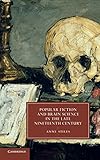Popular fiction and brain science in the late nineteenth century / Anne Stiles.
Series: Cambridge studies in nineteenth-century literature and culture ; 78.Publication details: Cambridge, U. K. : Cambridge University Press, 2012.Description: xi, 255 p. : ill. ; 24 cmISBN:- 9781107010017 (hbk.)
- 1107010012 (hbk.)
- Gothic fiction (Literary genre), English -- History and criticism
- Neurosciences and the arts
- Brain -- Research -- United Kingdom -- History -- 19th century
- Gothic revival (Literature) -- United Kingdom -- History -- 19th century
- Literature and science -- United Kingdom -- History -- 19th century
- Literature and medicine -- United Kindom -- History -- 19th century
- Neurosciences -- United Kingdom -- History -- 19th century
- Mind and body in literature
- Physiology in literature
- English fiction -- 19th century -- History and criticism
| Item type | Current library | Home library | Collection | Call number | Materials specified | Copy number | Status | Date due | Barcode | |
|---|---|---|---|---|---|---|---|---|---|---|
| AM | PERPUSTAKAAN TUN SERI LANANG | PERPUSTAKAAN TUN SERI LANANG KOLEKSI AM-P. TUN SERI LANANG (ARAS 5) | - | PR878.T3S754 (Browse shelf(Opens below)) | 1 | Available | 00002096209 |
Includes bibliographical references (p. 232-247) and index.
'In the 1860s and 1870s, leading neurologists used animal experimentation to establish that discrete sections of the brain regulate specific mental and physical functions. These discoveries had immediate medical benefits: David Ferrier's detailed cortical maps, for example, saved lives by helping surgeons locate brain tumors and haemorrhages without first opening up the skull. These experiments both incited controversy and stimulated creative thought, because they challenged the possibility of an extra-corporeal soul. This book examines the cultural impact of neurological experiments on late Victorian Gothic romances by Robert Louis Stevenson, Bram Stoker, H. G. Wells and others. Novels like Dracula and Jekyll and Hyde expressed the deep-seated fears and visionary possibilities suggested by cerebral localization research and offered a corrective to the linearity and objectivity of late Victorian neurology'-- Provided by publisher.
There are no comments on this title.

